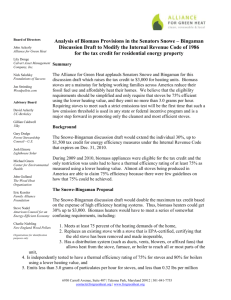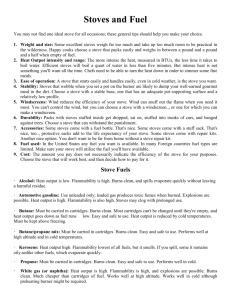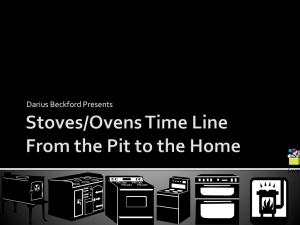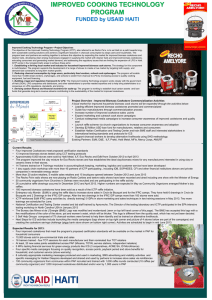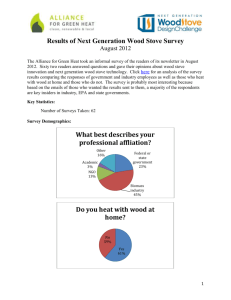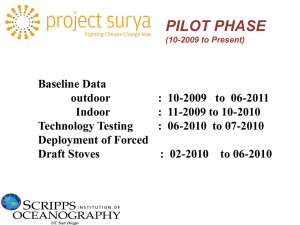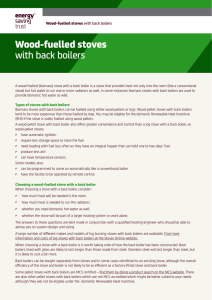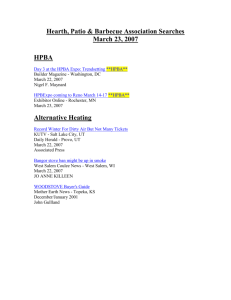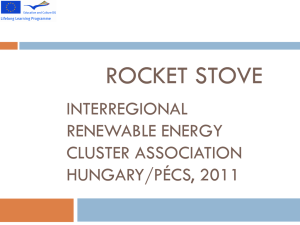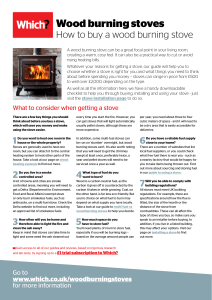Bangladesh Updated Results
advertisement
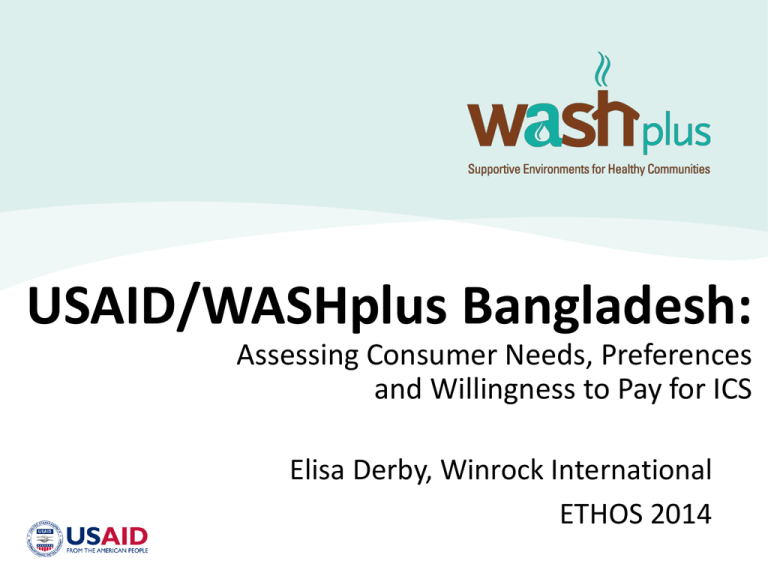
USAID/WASHplus Bangladesh: Assessing Consumer Needs, Preferences and Willingness to Pay for ICS Elisa Derby, Winrock International ETHOS 2014 What is WASHplus? WASHplus is a five-year (2010-2015) cooperative agreement funded through USAID’s Bureau for Global Health, managed by FHI 360 with Winrock and CARE as core partners. WASHplus supports healthy households and communities by creating and supporting interventions that lead to improvements in access, practice and health outcomes related to water supply, sanitation, and hygiene (WASH) and household air pollution (HAP). USAID/Bangladesh requested WASHplus assistance in exploring key consumer issues to contribute to CCEB, Global Alliance and other stakeholder efforts. Cross-cutting collaboration/funding (USAID Health and Energy, Asia Regional Bureau, Bangladesh mission, State/GPI, GACC ) Challenges If improved cookstoves have so many benefits, why is the problem so difficult to solve? 1. 2. 3. 4. 5. 6. 7. 8. No “one size fits all” cookstove Lab performance ≠ field performance The “best” stoves can be unappealing to cooks Stove “stacking” is the norm Lack of IAP health risk awareness Poverty Higher priorities for $ Lack of HH purchase decision making power Behavior Change Improved cookstove adoption depends on: 1. Access 2. Affordability (including financing) 3. Decision making power for purchases 4. Awareness and prioritization But getting a stove into someone’s home is only half the battle…. Sustained improved cookstove use depends on: 1. Correct operation and maintenance 2. Fuel availability and requirements 3. Cooking needs 4. Stoves ‘delivering’ benefits consumers want WASHplus also focuses on other BC techniques to lower exposure BC of users AND implementers Bangladesh Study Objectives Phase 1: Consumer needs, preferences, and willingness to pay to increase the adoption and correct and consistent use of improved cookstoves in Bangladesh. (Dec 2012 – Sept 2013) Phase 2: Marketing and behavior change strategy, evidence-based approaches to increase the uptake of stoves, practical “how-to” tools. Tools and resources for other Asia regional cookstove programs and implementers. (Sept 2013 – April 2014) Strong focus on evidence-based programming and gender. Builds on USAID-funded Winrock market assessment and other regional inputs. Results will feed into Bangladesh Mission’s CCEB program, Global Alliance activities, Bangladesh Country Action Plan, World Bank/IDCOL activities. Current options: Left: Traditional sunken-hole stove (2 pot version) Right: Bondhu chula; the current model of improved stove most widely disseminated in Bangladesh. Built-in place chimney stove. Consumer preference trials in-home testing over time Phase 1: Household consumer preference trials: • 5 stove types * 3 homes ea. * 2 divisions * 4 villages ea. = 120 hh Barisal (south) villages: Billobari, Bihangal, Ichakathi, and Gonpara Sylhet (NW) villages: Jangail, Kewa, Tilargaon, and Kunarchor • Representative of market – wood as primary fuel • Semi-structured questionnaires- qualitative and quantitative Installation and baseline 3 day initial assessment/problem solving visit 21 day final survey • Willingness to pay assessment, 2 methods • Kitchen Performance Tests • SUMS monitoring • IAP monitoring 5 stoves tested- focus on type, not brand Consumer Preference, WTP Envirofit Z3000 Single-pot built-in-place rocket-design stove EcoZoom Dura Single-pot portable rocket-design stove Prakti LeoChimney Two-pot metal chimney stove Greenway Smart Stove Single-pot portable natural draft gasifier stove Alpha Renewable Energy Eco Chula Single-pot portable fan (forced air) gasifier stove (battery/solar powered) Our Study Sample • Barisal (south) villages: Billobari, Bihangal, Ichakathi, and Gonpara • Sylhet (NW) villages: Jangail, Kewa, Tilargaon, and Kunarchor • Most families 4-5 people; average size of 5.3 • Primary wood fuel usage • Poor, but not the very bottom of the pyramid • All participants were 16–65 years old; about 60% of participants were cooks below 35 years old Key Findings • Households felt ALL STOVES WERE GOOD STOVES and recognized many benefits • NONE of the 5 stoves (as currently produced) meet all -- or even most -- consumer needs • NONE would completely replace traditional stoves • Cook satisfaction with the improved stoves DECREASED over the 3 week trial when compared to their responses after 3 days of use Overall Non-relative Opinions What did people like about the stoves? Decreasing satisfaction over time Preferences by District Problems identified by cooks Problems encountered & user solutions Problems Solutions suggested by Users Not stable while stirring Make the stove stable Ash builds up quickly Add ash tray Cannot cook in second pot due to lack of heat Increase heat in the second pot by placing fuel chamber between first and second pot Cannot cook large quantities of food like rice and takes longer to cook larges quantities Larger sizes of stoves should be available Fuel chamber small so wood fall off the Fuel chamber should be larger opening and charred wood and embers fall out Cannot use large wood pieces/cannot chop wood pieces, cannot effortlessly feed wood. Address problems related to wood size Flame does not spread Flame should reach vessel and be visible Difficult to ignite, and add small wood pieces, Pots become black and difficult to clean. -These ‘changes’ or ‘solutions’ revealing, but not something recommended for modifications/ implementation Who would buy? What Kind of People Would Use Frequency This (These) New Stoves? n = 120 % Small families Modern people Thrifty people Simple, ordinary family Someone people respect People/families living in cities Small families who buy fuel Smart people People living in rented apartment Rich families Bachelor 42 43 21 13 9 8 7 7 6 3 3 54 52 25 16 11 9 8 8 7 4 3 KPTs and SUMS KPTs funded through S-GPI Grant Cross-sectional, 116 study households, 24 control HHs IAP monitoring in a subset of 7 households: PM2.5 and CO KPT findings • Households using all but one model of improved stove (alongside their traditional stove) used 16-30% less fuel • Households using one model used 17% more fuel – installation and consumer education problem? • All stoves reduced IAP SUMS findings • All homes used improved stoves, but none did so exclusively • All homes used ALL stove less once we stopped coming to do daily measurements! Willingness to Pay Auction: 105 study participants given the option to purchase the stoves at market value ($19-54). Only one opted to do so, and a second nonparticipant neighbor purchased a stove. Buy back: 15 households were offered the stoves as gifts, then given an option of a cash buyout at market value ($19-54). Only three opted for the (relatively significant) cash; the other 12 preferred to keep their stove! When ‘acquisition barriers were removed, householders valued the stoves. Next Steps WASHplus Bangladesh Phase 2 runs through April: – Stove design improvements for the Bangladesh market, CCTs and further consumer preference testing! – Develop a generic marketing and behavior change strategy – Identify key segments most ready to purchase ICS – Apply a “4Ps” analysis (product, place, price and promotion) to the Bangladesh cookstove market: product, place, price and promotion for each segment – Concept test key elements of these approaches; and – Develop practical “how-to” tools to contribute to the goals and results of USAID energy and health objectives in Bangladesh WASHplus contacts Elisa Derby, WASHplus HHE Specialist Winrock International 617-524-0466 ederby@winrock.org Julia Rosenbaum, WASHplus Deputy Director and Senior Behavior Change Specialist FHI 360 202-884-8838 jrosenbaum@fhi360.org http://www.washplus.org

